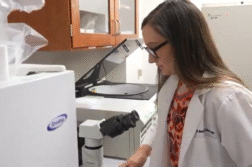ORLANDO, Fla. (Ivanhoe Newswire)— A recent warning from more than 200 scientists say that COVID-19 may be more infectious than previously thought. They state that COVID-19 can be transmitted through the air by particles that can linger for hours. Now a team of researchers have found a solution to these aerosols and it all starts with changing the way people spit. Cough Drops to fight off COVID-19.
A single cough … or sneeze … can send hundreds of virus particles that may carry the coronavirus into the air.
“If we could reduce the amount of droplets that are sustained in the air, I think it would be an effective measure,” explained Michael Kinzel, PhD, assistant professor at the University of Central Florida.
Is a cough drop the answer? This team is developing a product similar to a cough drop that can thicken saliva particles and make them heavier when released during a cough or sneeze.
“Then they will tend to fall down rather than transmit to the next person,” Kinzel clarified.
Using high-speed cameras, they use over-the-counter ingredients to test which will work best for their cough drop.
“Corn starch or peanut flour or agar agar, for example. These are good thickeners,” explained Kareem Ahmed, PhD assistant professor at the University of Central Florida.
The team expects their cough drop to last about 20 to 40 minutes for a trip to a grocery or a short flight. They also say the combination of their cough drop and a mask could decrease the space needed between people.
“It could bring the distance down to two feet, about a third of the CDC’s guideline distance,” Ahmed shared.
“Have people interact with each other more,” Kinzel concluded.
And bring back a little normalcy.
The team is hoping to make this product available to the public by the end of this year. They received a $200,000 National Science Foundation Rapid Response Research award to make that possible.
Contributors to this news report include: Cyndy McGrath, Executive Producer; Milvionne Chery, Field Producer; Roque Correa, Videographer & Editor.
To receive a free weekly e-mail on Medical Breakthroughs from Ivanhoe, sign up at: http://www.ivanhoe.com/ftk
MEDICAL BREAKTHROUGHS
RESEARCH SUMMARY
TOPIC: COUGH DROPS TO FIGHT OFF COVID?
REPORT: MB #4783
CORONAVIRUS BACKGROUND: Coronaviruses are a family of viruses that can cause illnesses such as the common cold, severe acute respiratory syndrome known as SARS and Middle East respiratory syndrome known as MERS. In 2019, a new coronavirus was identified as the cause of a disease outbreak that originated in Wuhan, China. The virus is now known as the severe acute respiratory syndrome coronavirus 2 (SARS-CoV-2). The disease it causes is called coronavirus disease 2019 (COVID-19). In March 2020, the World Health Organization (WHO) declared the COVID-19 outbreak a pandemic.
(Source: https://www.mayoclinic.org/diseases-conditions/coronavirus/symptoms-causes/syc-20479963)
MANAGING THE SPREAD OF CORONAVIRUS: The coronavirus spreads mainly from person to person. This can happen between people who are in close contact with one another. Droplets that are produced when an infected person coughs or sneezes may land in the mouths or noses of people who are nearby, or possibly be inhaled into their lungs. A person infected with coronavirus even with no symptoms may emit aerosols when they talk or breathe. Aerosols are infectious viral particles that can float or drift around in the air for up to three hours. Another person can breathe in these aerosols and become infected with the coronavirus. Therefore, everyone should cover their nose and mouth when they go out in public. Coronavirus can also spread from contact with infected surfaces or objects. Ways to help prevent the spread of COVID-19 include avoiding close contact with people who are sick, avoiding touching your eyes, nose, and mouth, staying home when you are sick, covering your cough or sneeze with a tissue and throwing the tissue in the trash, cleaning and disinfecting frequently touched objects and surfaces every day including counters, tabletops, doorknobs, bathroom fixtures, toilets, phones, keyboards, tablets, and bedside tables and washing your hands often with soap and water.
(Source: https://www.health.harvard.edu/diseases-and-conditions/preventing-the-spread-of-the-coronavirus)
A NEW WAY TO MANAGE THE SPREAD OF CORONAVIRUS: A team of University of Central Florida researchers is looking at changing people’s saliva by making it heavier and stickier using candy or corn starch to help sneeze and cough particles fall instead of float. The approach could lead to creating something as simple as a cough drop or lozenge that people would pop in their mouths before going into the grocery store, work, or school. The researchers are running numerical simulations to study how differences in viscosity, density, and surface tension impact droplet dispersal. They are also using high-speed cameras to characterize the patterns and distance traveled of droplets emitted from sneezing and coughing, including those that have been altered by candy or starch and they are finding similar reductions. Mike Kinzel, the project’s principal investigator and an Assistant Professor in UCF’s Department of Mechanical and Aerospace Engineering said, “One way to think about it is, for example, clouds are just little, tiny droplets that are suspended in the air for hours, and they just flow with the atmosphere. However, these droplets collide to form larger droplets that just fall out of the air. That is kind of the process we are trying to promote. We don’t want the droplets to blow around with the wind like a cloud, we want them to fall out of the sky like rain.”
FOR MORE INFORMATION ON THIS REPORT, PLEASE CONTACT:
ROBERT WELLS
UNIVERSITY OF CENTRAL FLORIDA
If this story or any other Ivanhoe story has impacted your life or prompted you or someone you know to seek or change treatments, please let us know by contacting Marjorie Bekaert Thomas at mthomas@ivanhoe.com




